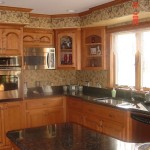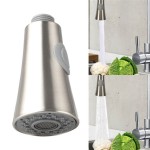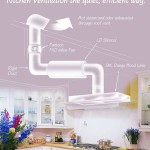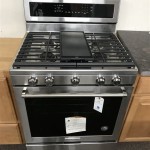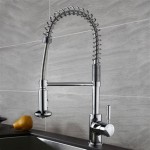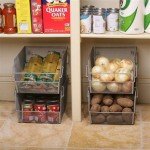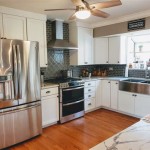What Can I Use To Decorate My Kitchen Walls?
Decorating kitchen walls presents a unique opportunity to infuse personality and style into a functional space. The kitchen, often considered the heart of the home, deserves aesthetic consideration that balances visual appeal with practicality. The selection of appropriate wall décor hinges on factors such as kitchen size, existing color schemes, personal taste, and budget. This article explores a variety of materials and techniques that can be employed to transform kitchen walls into visually engaging elements.
Before embarking on any decorating project, it is crucial to assess the existing conditions of the kitchen walls. This includes identifying any imperfections such as cracks, holes, or uneven surfaces. Addressing these issues before applying any decorative elements will ensure a smoother and more professional-looking final result. Cleaning the walls thoroughly to remove grease, grime, and dust is also a necessary preliminary step. This will allow for better adhesion of paint, wallpaper, or other decorative materials.
Consider the overall style and design aesthetic of the kitchen. Is it modern, traditional, farmhouse, or eclectic? The wall décor should complement and enhance the existing style, creating a cohesive and harmonious look. For instance, a modern kitchen might benefit from minimalist artwork and clean lines, while a farmhouse kitchen could embrace rustic textures and vintage-inspired pieces.
The size of the kitchen also plays a crucial role in determining the appropriate wall décor. In smaller kitchens, it is advisable to avoid overcrowding the walls with too many items. Opting for lighter colors and reflective surfaces can help to create the illusion of more space. Larger kitchens, on the other hand, can accommodate bolder colors, larger artwork, and more elaborate decorative elements.
Paint: A Versatile and Cost-Effective Option
Paint remains one of the most versatile and cost-effective options for decorating kitchen walls. It offers a wide range of colors, finishes, and textures to choose from, allowing for endless customization possibilities. When selecting paint for the kitchen, it is essential to choose a type that is specifically formulated for kitchens and bathrooms. These paints are typically moisture-resistant, mildew-resistant, and easy to clean. Semi-gloss or satin finishes are generally recommended for kitchen walls due to their durability and ease of maintenance.
Beyond selecting a single color for the entire kitchen, there are various painting techniques that can add visual interest and depth. Consider using two different colors to create an accent wall, or employing techniques such as stenciling, sponge painting, or color washing to add texture and dimension. Chalkboard paint is another popular option for kitchen walls, providing a functional and decorative surface for writing grocery lists, recipes, or leaving messages.
When choosing paint colors, it is important to consider the overall mood and atmosphere you want to create in the kitchen. Warm colors such as yellows, oranges, and reds can create a cozy and inviting atmosphere, while cool colors such as blues, greens, and purples can create a more calming and relaxing environment. Neutral colors such as white, gray, and beige provide a versatile backdrop that can be easily adapted to different styles and tastes. It's also wise to test paint colors in the specific lighting of your kitchen before committing to a full wall application, as colors can appear different under varying light conditions.
The careful selection of paint finish is also an essential consideration. Matte finishes absorb light and can conceal imperfections, making them suitable for walls with minor blemishes. However, matte finishes are generally less durable and more difficult to clean than other options. Semi-gloss finishes offer a balance between durability and ease of maintenance and are resistant to moisture, making them suitable for high-traffic areas like kitchens. High-gloss finishes are the most durable and easiest to clean, but they also reflect the most light and can highlight imperfections in the wall surface. Satin finishes are a popular choice for kitchen walls due to their subtle sheen, durability, and ease of cleaning.
Wallpaper: Adding Pattern and Texture
Wallpaper offers another avenue for kitchen wall decoration, providing an opportunity to introduce patterns, textures, and visual interest. Modern wallpapers come in a wide array of designs, from subtle textures and geometric patterns to bold florals and intricate murals. Selecting the right wallpaper can significantly transform the look and feel of a kitchen.
Similar to paint, choosing a wallpaper that is specifically designed for kitchens and bathrooms is important. These wallpapers are typically moisture-resistant, washable, and durable. Vinyl wallpapers are a popular choice for kitchens due to their ability to withstand moisture and grease. They are also easy to clean and maintain. Removable wallpapers, also known as peel-and-stick wallpapers, are a convenient option for renters or those who want to change their décor frequently. These wallpapers can be easily applied and removed without damaging the walls.
The choice of wallpaper pattern can greatly impact the overall look of the kitchen. Small patterns can create a subtle and understated effect, while large patterns can make a bold statement. Vertical stripes can make a room appear taller, while horizontal stripes can make a room appear wider. Consider the size and layout of the kitchen when selecting a wallpaper pattern. In smaller kitchens, it is best to avoid overly busy or overwhelming patterns. Larger kitchens can accommodate bolder and more elaborate designs.
Textured wallpapers can add another dimension to kitchen walls. Examples include grasscloth, embossed vinyl, and even wallpapers that mimic the look of brick or tile. These textures can add depth and visual interest to the space, creating a more tactile and engaging environment. Furthermore, the application of wallpaper requires careful preparation and execution. Walls must be clean, smooth, and properly primed to ensure proper adhesion. Air bubbles and misalignment can detract from the overall aesthetic appeal, thus proper measurement and installation are paramount.
Decorative Items: Art, Shelves, and Other Enhancements
Beyond paint and wallpaper, a variety of decorative items can be used to enhance kitchen walls. Art, shelves, and other enhancements can add personality, functionality, and visual interest to the space.
Artwork can be a powerful way to personalize a kitchen. Prints, paintings, photographs, and even framed recipes can add character and style to the walls. Consider the color scheme and style of the kitchen when selecting artwork. Choose pieces that complement the existing décor and reflect your personal taste. Smaller kitchens may benefit from smaller framed prints or a gallery wall of carefully curated pieces. Larger kitchens can accommodate larger, more impactful artwork.
Shelving provides both functional storage and decorative display space. Open shelving can be used to showcase dishes, glassware, cookbooks, or decorative objects. Floating shelves can create a clean and modern look, while rustic wooden shelves can add warmth and character. Consider the weight capacity of the shelves when selecting them. Ensure that they are strong enough to support the items you plan to display.
Other decorative elements that can be used to enhance kitchen walls include decorative mirrors, clocks, and kitchen-themed items such as utensil holders, spice racks, and decorative plates. Mirrors can help to create the illusion of more space and can reflect light, making the kitchen appear brighter. Clocks can add a functional and decorative touch. Kitchen-themed items can add personality and charm to the space.
The arrangement of decorative items on the walls is also a crucial consideration. A well-arranged gallery wall can create a visually stunning focal point. Hanging larger art pieces at eye level provides optimal viewing. Balancing the placement of shelves and other decorative elements across the wall space creates visual harmony. Additionally, ensuring that decorative items are securely mounted and properly spaced prevents a cluttered or haphazard appearance.
In summary, decorating kitchen walls involves a thoughtful consideration of various factors, including the existing style of the kitchen, the size of the space, and personal preferences. Paint, wallpaper, and decorative items each offer unique possibilities for transforming kitchen walls into visually engaging elements. By carefully selecting the right materials, colors, and techniques, it is possible to create a kitchen that is both functional and aesthetically pleasing.

11 Kitchen Decorating Ideas For Your Walls The Anastasia Co

21 Of The Best Ways To Decorate Kitchen Walls On A Budget Life Kaydeross Creek

21 Of The Best Ways To Decorate Kitchen Walls On A Budget Life Kaydeross Creek

14 Kitchen Wall Decor Ideas To Brighten The Space Society6

11 Kitchen Decorating Ideas For Your Walls The Anastasia Co

21 Kitchen Wall Decor Ideas To Spice Up Your Walls Displate Blog

How To Decorate Kitchen Walls 32 Creative Ideas Try

21 Of The Best Ways To Decorate Kitchen Walls On A Budget Life Kaydeross Creek

Kitchen Wall Decor How To Style Walls Chaylor Mads

20 Best Kitchen Wall Decor Ideas To Design Your Foyr
Related Posts

